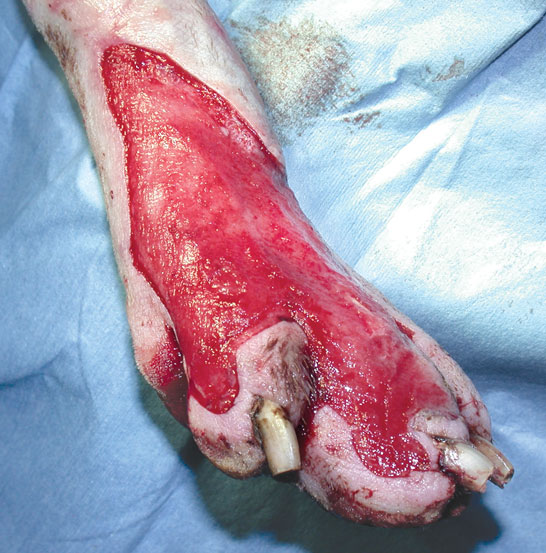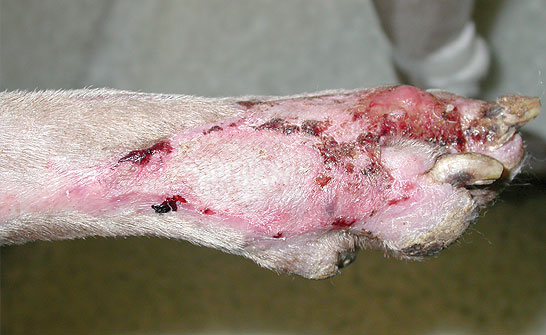Why Should I Bring my Pet to Willows for Wound Management?
All patients referred for treatment of problematic wounds at Willows are assessed by Specialist Soft Tissue Surgeon with a particular interest in wound management. Continuity of care is critical during wound management in order to understand any changes since the previous examination or dressing change.
At Willows, whenever possible the same Specialist will assess the wound at each dressing change. This allows the dressings applied to be tailored to the healing mechanisms in progress and to be altered if appropriate. Photographs are often used to keep an accurate record of the wound at each stage, to further aid in the assessment of healing and to help guide management options.
In some cases, a wound will benefit greatly from a relatively intensive treatment plan in the initial stages of care. At Willows, an affected pet can be admitted to hospital for daily wound treatment, and then cared for on an out-patient basis once healing is underway.
How are Wounds Assessed for Treatment
It is important that the Specialist is fully aware of any medical conditions that may affect a pet’s ability to heal or fight infection and so a detailed medical history is obtained from both the owner and the referring vet. The assessment process typically involves several stages including:
- Cause of the wound (e.g. barbed wire, dog bite, infection)
- Treatment used prior to referral and any progress that has been made
- Removal of the dressing and detailed investigation of the wound, this may require sedation or a short anaesthetic to allow the surgeon to fully explore the lesion
- Samples (biopsies) can be taken when appropriate for examination and culture to identify any bacteria that may be present.
Following this a summary of the findings will be given and an indication of the likely timeline and level of treatment required to get the best and most rapid result. Management of wounds often requires careful assessment on a day-by-day basis, therefore it is not possible to give very detailed advance predictions of exactly what will be required. The treatment plan will need to remain somewhat flexible in order to allow the surgeon to adapt to changes that occur in the wound itself.

What Techniques are Available to Treat Wounds?
Active dressings: Dressings include a component to increase the healing process. Materials including alginate, honey and silver can be used under appropriate circumstances
Secondary intention healing: Natural healing that occurs without the wound being stitched up
Direct closure: Following successful treatment of ongoing tissue damage, infection etc. some wounds can be closed directly (stitched up) in the operating theatre
Free skin grafts: Skin is harvested from a healthy site and placed elsewhere on the body to fill the wound
Reconstructive techniques: There is a wide range of skin reconstructive techniques. Our Specialist Soft Tissue Surgeons are trained in using many advanced types of reconstructive wound repair techniques
How Long will Treatment Take?
Successful wound management can be challenging and time. The tissues involved often need to be allowed time to react appropriately to the damage that caused the wound in the first instance, they then need time to respond to the treatment which is being administered.
Whilst the management will aim to help the natural processes to be as efficient as possible, wound care can require treatment over a prolonged period (several weeks in some cases).

Fig 1: A skin defect following a road traffic accident treated by application of a free skin graft. Before the skin graft procedure was performed, the wound was carefully managed using different dressing techniques to ensure the tissue was suitable to receive the graft.

Fig 2: This picture was taken three weeks following graft application. The graft has incorporated into the previous defect and the small area of raw tissue remaining is small enough to be managed by continued dressing changes.
Negative Pressure Wound Therapy (Vacuum Assisted Wound Care)
Negative Pressure Wound Therapy (NPWT) refers to a technique that involves connecting an airtight dressing to a semiportable vacuum device to achieve a constant level of highly controlled suction (negative pressure) on the wound.
The application of negative pressure changes gene expression and influences cytokine (chemicals used to control cell behaviour) concentrations in the wound environment with the result that the early phases of wound healing can be optimised and accelerated. NPWT increases the concentration of neutrophils (a type of white blood cell) and increases the formation of new blood vessels in the wound, which assists in the early formation of a healthy granulation tissue bed. Use of the system is usually limited to the early phases of wound management; once the wound is starting to heal, more conventional wound dressings are employed.
NPWT can also be useful to support free skin grafts and assist in healing of surgical wounds under tension or considered to be at risk of poor healing.
The Specialists at Willows have extensive experience of managing different types of wounds, and will suggest NPWT for your pet if they consider it likely to help the wound to heal.
To save this page as a PDF, click the button and make sure “Save as PDF” is selected.
Soft Tissue Surgery
Find out more
To assist owners in understanding more about Soft Tissue Surgery we have put together a range of information sheets to talk you through the some of the more common soft tissue conditions seen and treated by our Specialists.
Condition:
Treatment:

